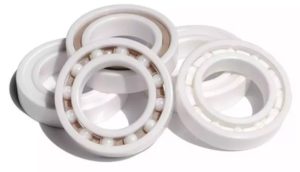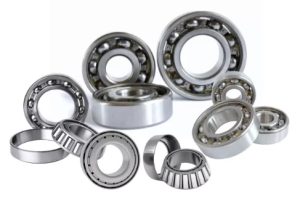Bearings are fundamental components in almost every moving mechanical system — from wheel hubs and transmissions to electric motors and suspension components. As engineering pushes vehicles to be more efficient, lighter, and more durable, the materials used in bearings are evolving rapidly. Ceramics, composites, and advanced alloys are at the forefront of this change. In this article we’ll explore what these materials bring, what trade-offs exist, and how they could shape the future of automotive bearing design.

Why Traditional Steel Bearings Have Limits
Before looking ahead, it’s important to understand what steel (and common bearing metals) do well, and where they struggle.
Strengths of steel bearings:
-
High load capacity (radial & thrust loads)
-
Good fatigue life under conventional conditions
-
Relatively low cost and well-understood manufacturing processes
Key drawbacks under modern demands:
-
Heavier weight → contributes to rotational mass, which reduces efficiency
-
Heat buildup under high RPM/high temperature, particularly in EV motors or turbocharged engines
-
Corrosion (especially in moist or salty environments)
-
Need for frequent lubrication and maintenance
These limitations motivate research into alternative materials, to meet the demands of electric vehicles, higher operating temperatures, lighter weight, and longer maintenance intervals.
Key Material Trends
Here are the main material technologies on the horizon for bearings:
| Material Type | Primary Advantages | Challenges / Trade-offs |
|---|---|---|
| Ceramic (or Hybrid Ceramic) | Very high hardness, low friction, excellent high-temperature stability, less thermal expansion, lighter weight. Good corrosion resistance. | Brittleness (risk of cracking under shock), higher cost, more difficult manufacturing, compatibility with steel races (in hybrids) needs careful design, sealing/lubrication under mixed conditions. |
| Composite Materials / Polymer-Based Bearings | Light weight, self-lubrication (or low lubrication), good corrosion resistance, often quieter, tolerant of misalignment or edge loads in some designs. | Lower load capacity vs premium steel or ceramic, temperature limits, creep or deformation under sustained load, sometimes more complex to manufacture, issues with wear under high speeds or abrasive contamination. |
| Advanced Alloys & Coatings (e.g. special steels, metal matrix composites, surface treatments) | Improve toughness, resistance to wear and fatigue, ability to incorporate coatings that reduce friction (e.g. nano-coatings, DLC), better heat dissipation. Hybrid metal/ceramic designs fall here. | Cost of exotic alloys and coatings, processing challenges, material compatibility (different expansion/coefficient, galvanic corrosion risk), supply chain and reproducibility concerns. |
Specific Trends & Use Cases
Here are several of the leading directions being pursued:
-
Hybrid Ceramic Bearings in Electric Vehicles (EVs):
Hybrid ceramic bearings combine ceramic rolling elements (e.g. ceramic balls or rollers) with steel or alloy races. The ceramic parts reduce heat generation, allow higher RPMs, and lower friction. Growth in this area has been rapid, especially driven by EV drivetrains. Costs remain higher, but performance benefits are strong. -
Silicon Nitride and Zirconia Ceramics:
These ceramics are increasingly used due to their hardness, thermal stability, and toughness. They perform well under extreme temperature and high speed. -
Composite / Reinforced Polymer Bearings:
Composites reinforced with fibers (e.g. carbon, glass), resins, and solid lubricants (PTFE, graphite, MoS₂) are being developed for bearing surfaces that require lower maintenance. These are especially useful in corrosion-prone areas, applications that require lighter weight, or where lubrication is difficult. -
Advanced Coatings & Surface Treatments:
Beyond base material, much of the advantage can come from advanced surface coatings: nano-layers, DLC (diamond-like carbon), other hard, low-friction surfaces. These reduce friction and wear of bearings regardless of base material. Hybrid ceramics often also incorporate advanced surface finishing. -
Additive Manufacturing & Custom Geometries:
3D printing and precision manufacturing are allowing complex bearing geometries, internal cooling or lubrication channels, custom lattice structures to reduce weight, and integrate materials in hybrid fashion. This complements high-performance material choices. -
Sustainability & Lower Life-Cycle Cost:
Lightweight and lower-friction materials reduce energy consumption. Materials with longer service life reduce waste. Composites that are recyclable or use bio-based resins are being researched. Also, manufacturing ceramic waste streams, better material yield, etc.
How These Trends Translate to Vehicle Performance
The material improvements aren’t just technical novelty; they deliver real benefits in vehicle use:
-
Improved efficiency / lower energy loss — less friction means less wasted energy, better fuel economy or EV range.
-
Higher durability / extended service intervals — fewer replacements, reduced maintenance downtime.
-
Greater reliability in demanding conditions — high temperature (turbo, EV motors), corrosive environments, water exposure.
-
Reduced mass — lighter bearings reduce unsprung or rotating mass, improving handling, acceleration, and braking.
Table: Material Comparison for Key Performance Metrics
| Metric | Steel Bearings (High-Quality) | Ceramic / Hybrid Ceramic | Composite Bearings |
|---|---|---|---|
| Coefficient of Friction | Moderate | Low to very low | Low to moderate |
| Heat Resistance | Good up to moderate temps | Excellent | Moderate (depends on resin & reinforcement) |
| Load Capacity | High | High (less in hybrids sometimes) | Moderate to high (less than ceramics/steel at extreme loads) |
| Corrosion Resistance | Poor (needs protection) | Very good | Excellent |
| Weight | Heavier | Lighter | Much lighter |
| Maintenance Needs | Regular lubrication, inspection | Less frequent | Low to minimal |
| Cost | Low-moderate | High | Varies (can be competitive) |
Challenges & Considerations
No material is perfect. Implementing these future technologies must consider:
-
Cost vs benefit trade-off: Ceramic and special composite solutions often cost much more up front. The total return depends on usage, operating environment, and maintenance savings.
-
Shock / impact resilience: Ceramics, for example, can be brittle under impact or sudden overloads. Designs must mitigate this.
-
Temperature extremes and thermal mismatch: Different materials expand and contract differently; hybrid assemblies must manage differential expansion (e.g. ceramic vs steel).
-
Manufacturing & standards: Tighter tolerances, quality control, and standardization are required to ensure reliability.
-
Lubrication and sealing: Even with self-lubricating composites or ceramic elements, seals and lubrication regimes matter — contamination, moisture, etc., still cause failure.
Where to Watch Material Deployment First
Some application areas likely to lead in adopting these innovations:
-
Electric vehicles (motors, wheel bearings, drivetrain) — high speed, reduced lubrication, heat.
-
Performance / motorsport / luxury vehicles — demanding environments reward the improved feel, lower friction, longevity.
-
Off-road or harsh environments — marine, salt, mud, chemicals — where corrosion and contamination are major concerns.
-
Aerospace and UAVs (where weight saving is critical).
How to Leverage These Materials When Selecting Bearings
If you’re in the market for high quality bearings, here are some guidelines to help:
-
Match material to your operating conditions — high temperature, moisture, load, speed.
-
Don’t simply choose “the strongest” — consider brittleness, lubrication, compatibility.
-
Consider hybrid ceramic options when you need performance—but ensure steel races are high quality.
-
For everyday reliability and low maintenance, composites can be very attractive.
-
Ensure there are good supporting components: seals, lubrication, mounting, alignment.
And if you need to purchase reliable, advanced bearings and hubs suitable for these modern materials, you can browse options to Buy Wheel Hub & Bearings online
that may offer ceramic, hybrid, or alternative material options depending on your vehicle.

Conclusion
The future of bearing materials is rapidly evolving. Ceramics, composites, and advanced alloys (including hybrid combinations) offer exciting possibilities: less friction, lighter weight, higher heat resistance, better corrosion protection, and longer service life.
But with great innovation come trade-offs: cost, brittleness, manufacturing complexity, and compatibility must be carefully managed. As the automotive industry moves forward — especially with EVs and performance vehicles — these materials will become increasingly common, driving improvements in vehicle efficiency, reliability, and longevity.
In short, staying informed about these trends lets you make smarter choices when selecting bearings — choosing components that align with performance goals, environmental demands, and real-world driving conditions. The bearing of tomorrow isn’t just about turning parts — it’s about turning tech.